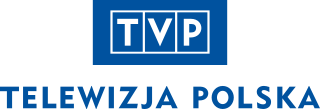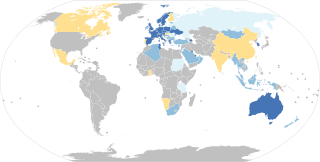Related Research Articles
The mass media in Poland consist of several different types of communications media including television, radio, cinema, newspapers, magazines, and Internet. During the communist regime in Poland the Stalinist press doctrine dominated and controlled Polish media. The country instituted freedom of press since the fall of communism. The Polish media system's main features are the product of the country's socio-political and economic post-communist transition. These features include: the privatisation of the press sector; the transformation of the state radio and television into public broadcasting services; influx of foreign capital into the media market and European integration of audiovisual media policies. Today the media landscape is very plural but highly polarized along political and ideological divides.

Digital Audio Broadcasting (DAB) is a digital radio standard for broadcasting digital audio radio services in many countries around the world, defined, supported, marketed and promoted by the WorldDAB organisation. The standard is dominant in Europe and is also used in Australia, and in parts of Africa and Asia.

BBC Radio 4 is a British national radio station owned and operated by the BBC that replaced the BBC Home Service in 1967. It broadcasts a wide variety of spoken-word programmes, including news, drama, comedy, science and history from the BBC's headquarters at Broadcasting House, London. The station controller is Mohit Bakaya.

Hits Radio is a network of 25 contemporary hit radio stations in the United Kingdom, owned and operated by Bauer Media Audio UK.

Kerrang! Radio is a specialist digital rock music radio station owned and operated by Bauer and forms part of the Kiss Network.

BBC Radio Cymru is a Welsh language radio network owned and operated by BBC Cymru Wales, a division of the BBC. It broadcasts on two stations across Wales on FM, DAB, digital TV and online.

Polskie Radio Spółka Akcyjna is Poland's national public-service radio broadcasting organization, owned by the State Treasury of Poland.

Telewizja Polska S.A., also known in English as Polish Television, is a state media corporation in Poland, founded in 1952. It is the oldest and largest Polish television network, although viewership has been declining in the 2010s.
Disco polo is a genre of popular dance music, created in Poland in the 1980s. It was initially known as "sidewalk music" or "backyard music". This genre, being a part of the musical folklore, had great popularity in the 1990s, with its peak in 1995-1997. Then the genre gradually declined in popularity up to the early 21st century. The comeback of disco polo happened in the winter of 2007. The Polish PWN dictionary defines the genre as a Polish variant of disco music, with simple melodies and often ribald lyrics. The service Rate Your Music defines disco polo as a Polish variant of dance-pop.

Polskie Radio Program II, also known as PR2 or Dwójka, is a radio channel produced by the Polish public broadcaster, Polskie Radio. It is dedicated to classical music, culture, and the arts. Thanks to its extensive cooperation with other public broadcasters from around the world, the channel provides numerous transmissions of concerts and other classical music events from every part of the globe. It is widely considered to be the most elite-targeted of all Polish radio channels. Its studios are located at the Polskie Radio headquarters in Warsaw. Program 2 often also uses a concert studio belonging to the public Polish Television (TVP).

Radio Poland is the official international broadcasting station of Poland.

The radio technology known as Digital Audio Broadcasting, and its TV sibling, Digital Multimedia Broadcasting (DMB), is being operated in several regions worldwide, either in the form of full services, or as feasibility studies.

Polskie Radio Program III, known also as Radiowa Trójka or shortly Trójka is a radio channel broadcast by the Polish public broadcaster, Polskie Radio. It is a music station playing a wide variety of music from rock, alternative, jazz and others. It is broadcast on FM, via satellite and online. The studios are located at Myśliwiecka Street 3/5/7 in Warsaw.

Anglo-Polish Radio is an on-demand bilingual audio content producer for Polish and English-speaking audiences in the United Kingdom and Ireland, formerly a broadcast radio station. The station was based in London and also broadcast to listeners in Poland. Bilingual journalist George Matlock, the son of two Poles, is Radio ORLA's founder. Since 18 May 2015, the station has been exclusively available as a podcast publisher. In 2020 ORLA.fm moved to a new website ORLAfm.Media in preparation for its relaunch with new content from 1 February 2022.

The Absolute Radio Network is a network of ten radio stations owned and operated by Bauer Radio. Bauer purchased the TIML Radio Limited network of stations in 2013. Most of the Absolute Radio stations are decade-themed services, alongside the flagship station and classic rock and country-formatted stations. The network is aimed at 35 to 54 year olds.

Polskie Radio Program IV, known also as PR4 or radiowa Czwórka is a radio channel broadcast by the Polish public broadcaster, Polskie Radio.
Białystok has a wide variety of media outlets serving the city and surrounding region. There are two locally published daily newspapers, Gazeta Współczesna and Kurier Poranny. In addition two national papers have local bureaus. There are a number of national and locally produced television and radio channels available both over-the-air from the nearby RTCN Białystok (Krynice) Mast, the seventh highest structure in Poland, in addition to transmitter sites within the city. There is also a cable television system available within the city. The city has two campus radio stations; Radiosupeł at the Medical University of Białystok and Radio Akadera at the Białystok Technical University.
Mass media in Jersey consist of several different types of communications media: television, radio, newspapers, magazines, and Internet-based Web sites.
The first radio broadcast in Poland happened on 1 February 1925 and the industry is still alive today.
References
- ↑ "Program IV Polskie Radio 24 od września na UKF. Czwórka tylko w internecie i na DAB+". wirtualnemedia.pl. Retrieved 2016-10-20.
- ↑ "Ramówka". polskieradio.pl. Retrieved 2016-10-20.
- ↑ "Częstotliwości - Polskie Radio 24 - polskieradio.pl". polskieradio.pl. Retrieved 2016-10-20.
- ↑ "Cyfryzacja ma zwiększyć zasięg, ale czy Polskie Radio nie ma już pełnego krajowego zasięgu? - Cyfrowe radio DAB - polskieradio.pl". polskieradio.pl. Retrieved 2016-10-20.